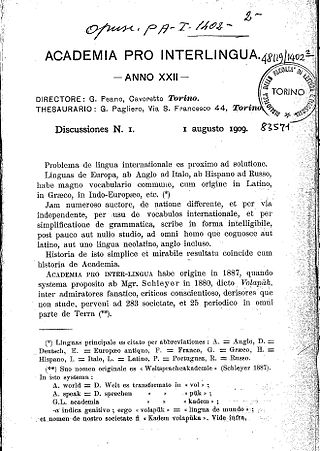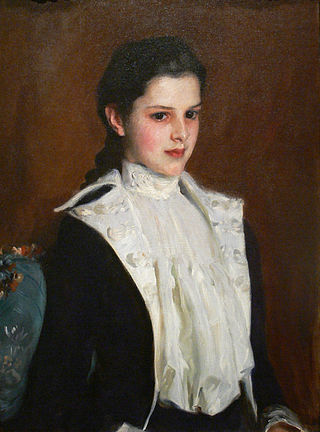Related Research Articles

Interlingua is an international auxiliary language (IAL) developed between 1937 and 1951 by the American International Auxiliary Language Association (IALA). It is a constructed language of the "naturalistic" variety, whose vocabulary, grammar, and other characteristics are derived from natural languages. Interlingua literature maintains that (written) Interlingua is comprehensible to the hundreds of millions of people who speak Romance languages, though it is actively spoken by only a few hundred.
An international auxiliary language is a language meant for communication between people from all different nations, who do not share a common first language. An auxiliary language is primarily a foreign language and often a constructed language. The concept is related to but separate from the idea of a lingua franca that people must use to communicate. The study of international auxiliary languages is interlinguistics.
International scientific vocabulary (ISV) comprises scientific and specialized words whose language of origin may or may not be certain, but which are in current use in several modern languages.
Alexander Gottfried Friedrich Gode-von Aesch was a German-born American linguist, translator and the driving force behind the creation of the auxiliary language Interlingua.
The term irregularities or exceptions in Interlingua refers to deviations from the logical rules in a few grammatical constructions in the international auxiliary language Interlingua. These oddities are a part of the standard grammar. These special cases have crept into the language as a result of the effort to keep it naturalistic. Most of these irregularities also exist in Interlingua's source languages; English, French, Italian, Spanish, Portuguese, and to a lesser extent German and Russian. This feature of the language makes Interlingua more familiar to the speakers of source languages. And at the same time, it makes the language more difficult for others.

The Academia pro Interlingua was an organization dedicated to the promotion of international auxiliary languages, and is associated in particular with Giuseppe Peano's language Latino sine flexione.
Interlinguistics, also known as cosmoglottics, as the science of planned languages, has existed for more than a century as a specific branch of linguistics for the study of various aspects of linguistic communication. Interlinguistics is a discipline formalized by Otto Jespersen in 1931 as the science of interlanguages, i.e. contact languages tailored for international communication. In more recent times, the object of study of interlinguistics was put into relation with language planning, the collection of strategies to deliberately influence the structure and function of a living language. In this framework, interlanguages become a subset of planned languages, i.e. extreme cases of language planning.
The International Auxiliary Language Association, Inc. (IALA) was an American organisation founded in 1924 to "promote widespread study, discussion and publicity of all questions involved in the establishment of an auxiliary language, together with research and experiment that may hasten such establishment in an intelligent manner and on stable foundations." Although it was created to determine which auxiliary language of a wide field of contenders was best suited for international communication, it eventually determined that none of them was up to the task and developed its own language, Interlingua.
Stanley Allen Mulaik is Professor Emeritus (retired) at the School of Psychology at the Georgia Institute of Technology, as well as the head of the Societate American pro Interlingua. Although born in Edinburg, Mulaik lived in Salt Lake City, Utah from 1939 to 1966. For the last 42 years, he has lived in or around the Atlanta, Georgia area. He has two sons who live with their families in the Atlanta area.
Ido and Interlingua are two constructed languages created in the 20th century, Ido circa 1910 and Interlingua circa 1940. Both have had some measure of success, but Interlingua has enjoyed greater diffusion and acceptance by public and private institutions—it is taught in many high schools and universities, for example. Ido was developed by a small committee from Reformed Esperanto, whereas Interlingua was developed from scratch by an American organization, the IALA.
Herbert Newhard Shenton was a professor of Sociology at Columbia University and later at Syracuse University in New York. He was executive secretary of the International Auxiliary Language Association (IALA) from 1924 until his death in 1937. The interlinguistic work of IALA culminated in the publication of the Interlingua–English Dictionary and Interlingua Grammar in 1951. Through these historic works, IALA first presented Interlingua to the general public.
Ezra Clark Stillman (1907–1995) laid out the criteria for extracting and standardizing the vocabulary of Interlingua. In 1937, Stillman replaced William Edward Collinson as Director of Research at the International Auxiliary Language Association (IALA), which presented Interlingua to the public in 1951.
William Edward Collinson was a British linguist and, from 1914 to 1954, Chair of German at the University of Liverpool. Like Edward Sapir and Otto Jespersen, he collaborated with Alice Vanderbilt Morris to develop the research program of the International Auxiliary Language Association (IALA). From 1936 to 1939, he was Research Director of IALA. Under Collinson's guidance, methods of compiling international word material were tested at Liverpool. In 1939 IALA moved from Liverpool to New York and E. Clark Stillman succeeded Collinson as Research Director. Alexander Gode, editor of the first English-Interlingua dictionary published in 1951, remained in contact with Collinson which had collected much of linguistic material in the University of Liverpool.

Alice Vanderbilt Shepard Morris was a member of the Vanderbilt family. She co-founded the International Auxiliary Language Association (IALA).
The Interlingua–English Dictionary (IED), developed by the International Auxiliary Language Association (IALA) under the direction of Alexander Gode and published by Storm Publishers in 1951, is the first Interlingua dictionary of the world.
The IED includes about 27,000 words drawn from about 10,000 roots, but the bulk is given by about 600 classical latin roots, being an Anglo-Latin dictionary with English as the primary control language of the biggest romance languages .
For each etymological family the dictionary highlight the primitive word followed by very many cognates words. This method of condensing in a framework the etymological derivation has been taken up by the best multilingual and etymological modern dictionaries.
The IED dictionary also presents 125 affixes that facilitate to understand the neolatin linguistic word-formation. Its full title is Interlingua: A Dictionary of the International Language.
Interlingua: A Grammar of the International Language, sometimes called the Interlingua Grammar, is the first grammar of Interlingua. Released in 1951 by the International Auxiliary Language Association (IALA), it remains an authoritative reference work for Interlingua speakers and students of linguistics.
Interlingua a Prime Vista is a manual developed by Alexander Gode as a basic introduction to Interlingua. Gode had collaborated with Ezra Clark Stillman on a manual Spanish at Sight. Published in 1943, this book utilized a procedure for learning a language using only text in that language, accompanied by illustrations. Gode had continued the series with Portuguese at Sight, published later that year, and French at Sight, published the following year. He used the same procedure for Interlingua a Prime Vista.

A pan-Romance language or Romance interlanguage is a codified linguistic variety which synthesizes the variation of the Romance languages and is representative of these as a whole. It can be seen as a standard language proposal for the whole language family but is generally considered a zonal constructed language because it's the result of intense codification. Zonal languages are, according to interlinguist Detlev Blanke, constructed languages which "arise by choosing or mixing linguistic elements in a language group".
Interlingue and Interlingua are constructed international auxiliary languages.
The constructed language Interlingue, originally known as Occidental, has a history spanning a century since its original publication by its creator Edgar de Wahl in 1922.
References
- Stenström, Ingvar (2006). "Alexander Gode haberea 100 annos [Alexander Gode would have been 100 years old]". Panorama in Interlingua (5).